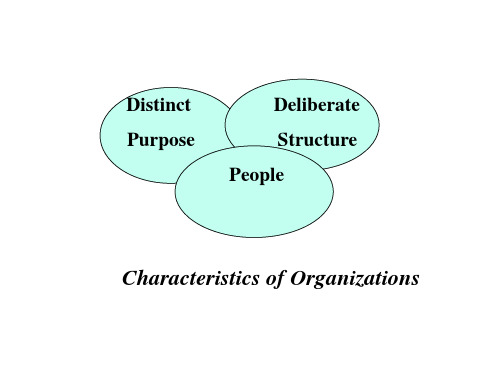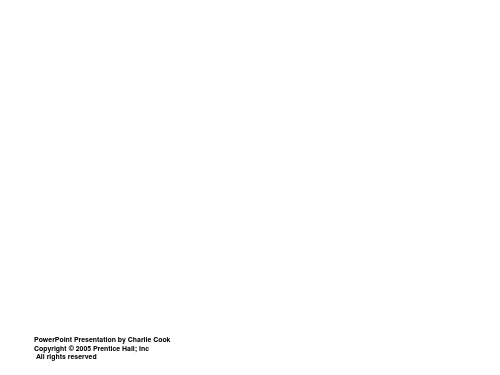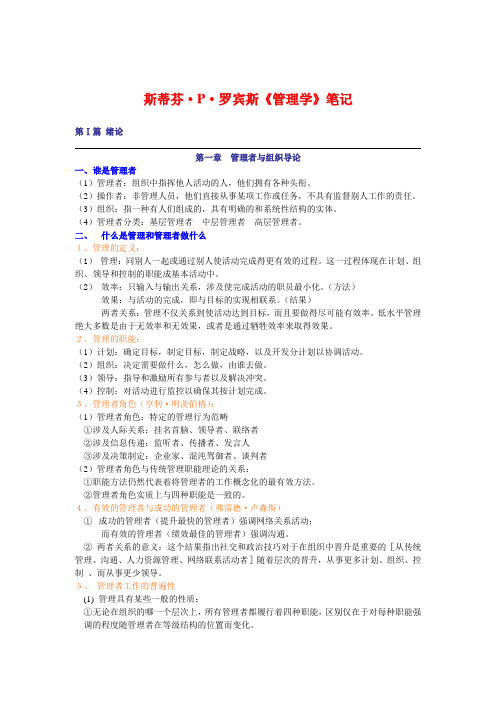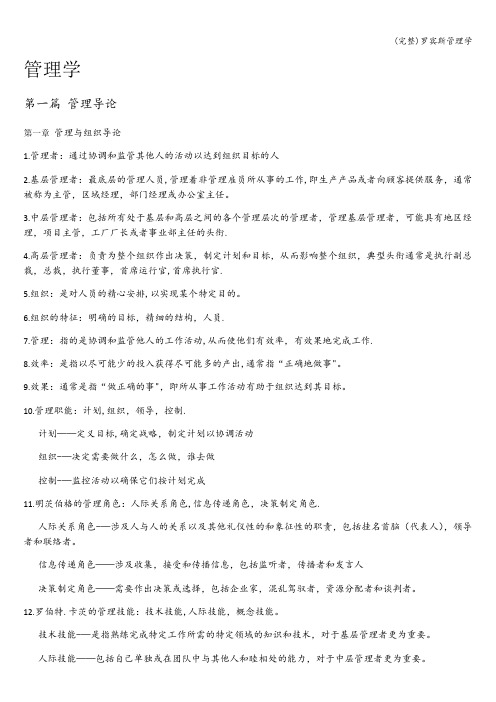罗宾斯管理学章节课件 (21)
罗宾斯管理学七版课件上海交大ppt课件

五、讨论题 1、产业革命为什么增加了对管理理论的需求? 2、为什么管理的过程方法更具有综合性? 六、案例分析 1、再创专业纽扣公司 2、升任公司总裁后的思考
第三章 文化与环境对管理实践的约束
当你是市场中的第四或者第五的时候,一旦市场
中的老大打一个喷嚏,你就会染上肺炎。
——杰克‧韦尔奇
过程方法是基于管理职能的,这些职能(计 划、组织、领导、控制)被看成是一个连续 的循环过程。
2、系统方法
(1)系统方法是是将系统定义为一组相互联 系和相互制约的要素按一定的方式形成的整 体。
(2)系统的分类:封闭系统;开放系统
3、权变方法(情境方法) 一般的权变变量: (1)组织规模; (2)任务技术的例常性 (3)环境的不确定性 (4)个人差异 四、当前的趋势和问题:变化中的管理实践
罗宾斯管理学七版课件上海交大ppt课件
学完第一章后,你应当能够: 1、区分管理者和操作者 2、定义管理 3、区分效果和效率 4、确定管理者扮演的角色 5、区分成功的管理者和有效的管理者的活动 6、说明管理者的工作是否具有普遍性
一、管理者与操作者
1、组织及其特征
组织是对完成特定使命的人们的系统性安排。 每一个组织都有三个共同的特征:明确的目 的(用目标来表示)、人组成、发育出系统 性结构(用以规范和限制组织成员的行为)。
2、组织中的所有的成员可分为两类:管理者 和操作者。
3、从外表看,管理者没有固定的模式,可以 是年纪不满18岁的未成年人,也可以是年逾8
旬的老人。他们可以是各种身材、各种模样、 各种肤色和不同性别的人。
4、韦斯特彻斯曼认为:管理者是一个在多种 可选的方案中进行决策的人。他必须确定自 己认为将导致某一个或几个期望目标的选择, 同时他的决定并不抽象,因为它将创造一种 真实。管理者是一个带有魔力的人,魔力使 他能够在世界上创造事物的新状态,而这种 状态若非他就根本不可能出现。管理者是一 个有权作出决定的人。他还是这样一个人, 他对自己所做的
罗宾斯管理学英文版课件

first-line
middle
managers managers
conceptual skills
top mangers
human skills
technical skills
Skills Needed at Different Management Levels
proficiently perform specific tasks.
human skills
The ability to work well with other people individually and in a group
conceptual skills
The ability to think and to conceptualize about abstract
work of the first-line managers.
top managers
Managers at or near the top level of the organization who are responsible for making
organization-wide decisions and establishing the goals and plans that affect the entire organization.
Management
Coordinating and overseeing the work activities of others so that their activities are completed
efficiently and effectively.
罗宾斯《管理学》原版讲义

Copyright © 2005 Prentice Hall; Inc All rights reserved
11
Organizational Culture
Copyright © 2005 Prentice Hall; Inc All rights reserved
2
LEARNING OUTLINE
Follow this Learning Outline as you read and study this chapter
The Organization’s Culture cont’d
❖ Values; symbols; rituals; myths; and practices
➢ Implications:
❖ Culture is a perception ❖ Culture is shared ❖ Culture is descriptive
Copyright © 2005 Prentice Hall; Inc All rights reserved
➢ The ability of managers to affect outes is influenced and constrained by external factors
❖ The economy; customers; governmental policies; petitors; industry conditions; technology; and the actions of previous managers
斯蒂芬·P·罗宾斯第九版《管理学》讲义DOC

斯蒂芬·P·罗宾斯《管理学》笔记第Ⅰ篇绪论第一章管理者与组织导论一、谁是管理者(1)管理者:组织中指挥他人活动的人,他们拥有各种头衔。
(2)操作者:非管理人员,他们直接从事某项工作或任务,不具有监督别人工作的责任。
(3)组织:指一种有人们组成的,具有明确的和系统性结构的实体。
(4)管理者分类:基层管理者中层管理者高层管理者。
二、什么是管理和管理者做什么1、管理的定义:(1)管理:同别人一起或通过别人使活动完成得更有效的过程。
这一过程体现在计划、组织、领导和控制的职能成基本活动中。
(2)效率:只输入与输出关系,涉及使完成活动的职员最小化。
(方法)效果:与活动的完成,即与目标的实现相联系。
(结果)两者关系:管理不仅关系到使活动达到目标,而且要做得尽可能有效率。
低水平管理绝大多数是由于无效率和无效果,或者是通过牺牲效率来取得效果。
2、管理的职能:(1)计划:确定目标,制定目标,制定战略,以及开发分计划以协调活动。
(2)组织:决定需要做什么,怎么做,由谁去做。
(3)领导:指导和激励所有参与者以及解决冲突。
(4)控制:对活动进行监控以确保其按计划完成。
3、管理者角色(亨利·明茨伯格):(1)管理者角色:特定的管理行为范畴①涉及人际关系:挂名首脑、领导者、联络者②涉及信息传递:监听者、传播者、发言人③涉及决策制定:企业家、混沌驾御者、谈判者(2)管理者角色与传统管理职能理论的关系:①职能方法仍然代表着将管理者的工作概念化的最有效方法。
②管理者角色实质上与四种职能是一致的。
4、有效的管理者与成功的管理者(弗雷德·卢森斯)①成功的管理者(提升最快的管理者)强调网络关系活动;而有效的管理者(绩效最佳的管理者)强调沟通。
②两者关系的意义:这个结果指出社交和政治技巧对于在组织中晋升是重要的[从传统管理、沟通、人力资源管理、网络联系活动者]随着层次的晋升,从事更多计划、组织、控制、而从事更少领导。
罗宾斯管理学原理PPT课件

第9页/共49页
态度调查
• 态度调查 • 态度调查包括一系列的问题,用于了解员工对自己的工作、工作小组、上级主管部门或组织的感受 • 态度调查为管理者提供员工对组织和他们的工作的任职的反馈
10–10
第10页/共49页
态度的重要性
• 对管理者的意义 • 态度是对潜在的行为问题的一种预警: • 管理者应该在激发员工积极的工作态度方面有所作为,因为这样可以降低缺勤率和辞职率 • 态度影响员工的行为: • 管理者应该关注于帮助提高员工的工作热情,从而提升工作满意度 • 员工将试图减少失调,除非: • 管理者能够找到造成这种失调的外部来源 • 管理者能够为这种失调提供奖赏作为补偿
为什么要了解组织与个人行为?
• 组织行为学 (OB) • 关注人们在工作中的活动
• 组织行为学关注的焦点 • 个体行为 • 态度、人格、认知、学习和激励 • 群体行为 • 规范、角色、团队建设、领导和冲突
• 组织行为的目的 • 为了解释、预测和影响行为
10–1
第1页/共49页
图表 10.1 组织犹如一座冰山
第32页/共49页
10–32
图表 10–7 群体行为模型
第33页/共49页
10–33
群体结构
• 角色
• 角色指的是在一个社会单元中,人们对于占据特定位置的个体所期望的一套行为模式。这些角色指向 任务的完成,或者指向维持群体成员的满意度
• 角色冲突: 扮演不同的角色,需要不同的经验 • 角色的不确定性: 角色预期的不确定性
图表 10.2 霍兰德的人格类型与职业范例
Source: Based on J. L. Holland, Making Vocational Choices: A Theory of Vocational Personalities and Work Environments (Odessa, FL: Psychological Assessment Resources, 1997).
30罗宾斯管理学 第13版 (21)

18 - 17
COPYRIGHT © 2016 PEARSON EDUCATION, INC.
图表18—7
热门的行业及公司排名
《产业周刊》 () 《产业周刊》1 000强企业 《产业周刊》美国500强企业 最佳制造企业500强 《产业周刊》最佳工厂
顾客满意度指数 美国顾客满意度指数——密歇 根大学商学院 顾客满意度测量协会 (Customer Satisfaction Measurement Association)
COPYRIGHT © 2016 PEARSON EDUCATION, INC.
18 - 16
组织绩效的测量
生产率(productivity)是产品或服务的总产出除以产 生这些产出的总投入。 • 组织效力(organizational effectiveness)是对组 织目标的合适程度及实现程度的测量。
18 - 12
控制过程(续)
步骤3:采取管理行动
– 直接纠正行动(immediate corrective action)— —为了立即纠正问题以使绩效回到正确轨道上 所采取的行为。 – 彻底纠正行动(basic corrective action)——首 先考察绩效偏差产生的原因和机制,然后纠正产 生偏差的根源。
18 - 14
图表18—6
控制过程中的管理决策
COPYRIGHT © 2016 PEARSON EDUCATION, INC.
18 - 15
什么是组织绩效?
绩效(performance)是一项活动的最终结果。
• 组织绩效(organizational performance)——所 有组织活动结果的累积结果。
18 - 10
COPYRIGHT © 2016 PEARSON EDUCATION, INC.
罗宾斯《管理学》原版讲义PPT精选文档

➢ Discretionary behavior that is not a part of an employee’s formal job requirements, but which promotes the effective functioning of the organization.
8th edition Steven P. Robbins
Mary Coulter
Copyright © 2005 Prentice Hall, Inc. All rights reserved.
LEARNING OUTLINE
Follow this Learning Outline as you read and study this chapter.
14–3
L E A R N I N G O U T L I N E (cont’d)
Follow this Learning Outline as you read and study this chapter.
Perception
• Explain how an understanding of perception can help managers better understand individual behavior.
• Discuss how managers can shape behavior.
14–4
Understanding Individual Behavior
• Organizational Behavior (OB)
➢ The actions of people at work
罗宾斯管理学通用课件

企业应通过制定可持续发展战略、建立企业公民意识、加强与利益 相关方的沟通等方式来实现其企业社会责任。
07
全球化与管理
全球化对管理的影响
01
全球化对组织结构的影响
全球化使得企业需要更加灵活和适应性强的组织结构,以应对不同国家
和市场的需求和变化。
02
全球化对人力资源管理的影响
全球化使得企业需要更加多元化和包容性更强的人力资源管理策略,以
03
管理职能
计划
计划的概念
计划是对未来行动方案的一种说 明,它规定了组织的目标、战略、 政策,以及实现这些目标所需要 的资源。
计划的作用
计划有助于组织成员明确自己的 工作目标,协调组织活动,减少 未来的不确定性,提高组织的效率。
计划的类型
按照不同的分类标准,可以将计 划分为长期计划、中期计划和短 期计划,战略计划、战术计划和 作业计划等。
管理道德的实践 管理者应通过自身的行为示范、制定符合道德规范的政策 和流程、以及建立有效的监督机制等方式来实践管理道德。
管理责任
管理责任的界定
管理责任是指管理者对其管理范围内的行为和结果所承担的义务和责任,包括对组织的责 任、对股东的责任、对员工的责任等。
管理责任的履行
管理者应通过制定明确的目标、建立有效的内部控制系统、实施风险管理等方式来履行其 管理责任。
详细描述
人类关系理论强调组织中的人际关系和行为对组织绩效的影响。它主张通过建立良好的人际关系和团队氛围来提 高员工的满意度和绩效。该理论还强调管理者应该关注员工的需要和利益,以及如何通过有效的沟通和激励来激 发员工的潜力。
现代管理理论
总结词
现代管理理论涵盖了多种不同的管理思想和理论。
(完整)罗宾斯管理学

管理学第一篇管理导论第一章管理与组织导论1.管理者:通过协调和监管其他人的活动以达到组织目标的人2.基层管理者:最底层的管理人员,管理着非管理雇员所从事的工作,即生产产品或者向顾客提供服务,通常被称为主管,区域经理,部门经理或办公室主任。
3.中层管理者:包括所有处于基层和高层之间的各个管理层次的管理者,管理基层管理者,可能具有地区经理,项目主管,工厂厂长或者事业部主任的头衔.4.高层管理者:负责为整个组织作出决策,制定计划和目标,从而影响整个组织,典型头衔通常是执行副总裁,总裁,执行董事,首席运行官,首席执行官.5.组织:是对人员的精心安排,以实现某个特定目的。
6.组织的特征:明确的目标,精细的结构,人员.7.管理:指的是协调和监管他人的工作活动,从而使他们有效率,有效果地完成工作.8.效率:是指以尽可能少的投入获得尽可能多的产出,通常指“正确地做事"。
9.效果:通常是指“做正确的事",即所从事工作活动有助于组织达到其目标。
10.管理职能:计划,组织,领导,控制.计划——定义目标,确定战略,制定计划以协调活动组织-—决定需要做什么,怎么做,谁去做控制-—监控活动以确保它们按计划完成11.明茨伯格的管理角色:人际关系角色,信息传递角色,决策制定角色.人际关系角色-—涉及人与人的关系以及其他礼仪性的和象征性的职责,包括挂名首脑(代表人),领导者和联络者。
信息传递角色——涉及收集,接受和传播信息,包括监听者,传播者和发言人决策制定角色——需要作出决策或选择,包括企业家,混乱驾驭者,资源分配者和谈判者。
12.罗伯特.卡茨的管理技能:技术技能,人际技能,概念技能。
技术技能-—是指熟练完成特定工作所需的特定领域的知识和技术,对于基层管理者更为重要。
人际技能——包括自己单独或在团队中与其他人和睦相处的能力,对于中层管理者更为重要。
概念技能——是管理者用来对抽象,复杂的情况进行思考和概念化的技能,对于高层管理者更为重要。
- 1、下载文档前请自行甄别文档内容的完整性,平台不提供额外的编辑、内容补充、找答案等附加服务。
- 2、"仅部分预览"的文档,不可在线预览部分如存在完整性等问题,可反馈申请退款(可完整预览的文档不适用该条件!)。
- 3、如文档侵犯您的权益,请联系客服反馈,我们会尽快为您处理(人工客服工作时间:9:00-18:30)。
– To ensure that activities are completed in ways that lead to the accomplishment of organizational goals.
COPYRIGHT © 2016 PEARSON EDUCATION, INC.
THE CONTROL PROCESS (CONT.)
Step 2: Comparing Actual Performance Against the Standard:
– Determining the degree of variation between actual performance and the standard.
– Range of variation – the acceptable parameters of variance between actual performance and the standard.
COPYRIGHT © 2016 PEARSON EDUCATION, INC.
18 - 10
COPYRIGHT © 2016 PEARSON EDUCATION, INC.
18 ቤተ መጻሕፍቲ ባይዱ 16
MEASURES OF ORGANIZATIONAL PERFORMANCE
Productivity– the amount of goods or services produced divided by the inputs needed to generate that output.
– Empowering employees – control systems provide managers with information and feedback on employee performance.
– Protecting the workplace – controls enhance physical security and help minimize workplace disruptions.
Control process – a three-step process of measuring actual performance, comparing actual performance against a standard, and taking managerial action to correct deviations or inadequate standards.
• Management by walking around – a term used to describe when a manager is out in the work area interacting directly with employees.
• Feedback control – control that takes place after a work activity is done.
18 - 17
EXHIBIT 18-7 POPULAR INDUSTRY AND
COMPANY RANKINGS
COPYRIGHT © 2016 PEARSON EDUCATION, INC.
18 - 18
CONTROLLING FOR EMPLOYEE PERFORMANCE
Disciplinary actions – actions taken by a manager to enforce the organization’s work standards and regulations.
COPYRIGHT © 2016 PEARSON EDUCATION, INC.
18 - 19
EXHIBIT 18-8 TYPES OF DISCIPLINE PROBLEMS AND
EXAMPLES OF EACH
COPYRIGHT © 2016 PEARSON EDUCATION, INC.
18 - 20
COPYRIGHT © 2016 PEARSON EDUCATION, INC.
18 - 4
EXHIBIT 18-1 PLANNING-CONTROLLING LINK
COPYRIGHT © 2016 PEARSON EDUCATION, INC.
18 - 5
THE CONTROL PROCESS
COPYRIGHT © 2016 PEARSON EDUCATION, INC.
18 - 6
EXHIBIT 18-2 THE CONTROL PROCESS
COPYRIGHT © 2016 PEARSON EDUCATION, INC.
18 - 7
THE CONTROL PROCESS (CONT.)
– Basic corrective action – corrective action that looks at how and why performance deviated before correcting the source of deviation.
COPYRIGHT © 2016 PEARSON EDUCATION, INC.
• Delivering Effective Performance Feedback – managers need to provide their employees with feedback so that the employees know where they stand in terms of their work.
Step 1: Measuring Actual Performance
– How We Measure – personal observations, statistical reports, oral reports, and written reports.
– What We Measure – what is measured is probably more critical to the control process than how it’s measured.
COPYRIGHT © 2016 PEARSON EDUCATION, INC.
18 - 21
EXHIBIT 18-9 TYPES OF CONTROL
COPYRIGHT © 2016 PEARSON EDUCATION, INC.
▪ Develop your skill at dealing with difficult people.
COPYRIGHT © 2016 PEARSON EDUCATION, INC.
18 - 2
WHAT IS CONTROLLING?
Controlling – the process of monitoring, comparing, and correcting work performance.
18 - 13
THE CONTROL PROCESS (CONT.)
Step 3 (cont.) – Revise the Standard – if performance consistently exceeds the goal, then a manager should look at whether the goal is too easy and needs to be raised. – Managers must be cautious about revising a standard downward.
WHAT IS ORGANIZATIONAL PERFORMANCE?
Performance – the end result of an activity.
• Organizational performance – the accumulated results of all the organization’s work activities.
18 - 12
THE CONTROL PROCESS (CONT.)
Step 3: Taking Managerial Action
– Immediate corrective action – corrective action that corrects problems at once in order to get performance back on track.
18 - 3
WHY IS CONTROLLING IMPORTANT?
As the final link in management functions:
– Planning – controls let managers know whether their goals and plans are on target and what future actions to take.
COPYRIGHT © 2016 PEARSON EDUCATION, INC.
18 - 14
EXHIBIT 18-6 MANAGERIAL DECISIONS IN THE CONTROL PROCESS
COPYRIGHT © 2016 PEARSON EDUCATION, INC.
18 - 15
TOOLS FOR MEASURING ORGANIZATIONAL PERFORMANCE
• Feed forward control – control that takes place before a work activity is done.
• Concurrent control – control that takes place while a work activity is in progress.
